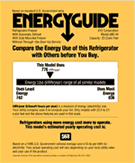Dishwashers
Get Rebates,
Incentives & Services
Introduction
Approximately 80% of the energy used by dishwashers goes toward heating the water. Manufacturers have found ways to reduce the amount of water used and/or heat the water more efficiently to significantly improve the energy efficiency of a dishwasher. New dishwasher designs have reduced water use by including more-efficient washing cycles and controls that allow you to tailor each wash to the specific characteristics of the load.
Consumers can save $25 to $35 a year in energy costs by replacing a 10-year-old dishwasher with an ENERGY STAR qualified model, and save more than 1,000 gallons of water. Because the average dishwasher is designed to last up to 12 years, savings from a new energy-efficient dishwasher can add up when multiplied over the life of the machine.
Technology Options
There are two models of dishwashers: compact capacity or standard capacity. Although compact-capacity dishwashers may appear to be more energy efficient, they hold fewer dishes and may force you to use the appliance more frequently than you would use a standard-capacity model. In this case, your energy costs could be higher than with the standard-capacity dishwasher. Choose the type that best matches your household's needs.
Dishwasher efficiency is measured by its Energy Factor (EF). The EF allows you to compare the relative efficiency of different models and is calculated based on the estimated number of loads per year divided by the annual energy usage (kilowatt-hours/year). The higher the EF, the more efficient the dishwasher. The federal minimum standard EF for dishwashers is 0.46. To qualify as an ENERGY STAR product, the dishwasher must have an EF at least 25% above the federal minimum standard or a minimum EF of 0.58. Dishwashers operating at the minimum standard use 573 kilowatt-hours (kWh)/year for 264 loads. The most efficient models on the market use as little as 204 kWh annually and have an EF of 1.29, according to the American Council for an Energy-Efficient Economy (ACEEE).
Dishwasher efficiency has improved dramatically in the past 10 to 15 years, mainly through more efficient use of hot water. Soil-sensors allow for the washer to determine the wash cycle length and the water temperature necessary to clean the dishes. Most dishwashers require water temperatures of 140°F to ensure optimal cleaning. This temperature is higher than the 120°F temperature water that is sufficient for other uses in the home. Built-in booster heaters are available on some dishwashers that will increase the temperature of the water entering the unit to the 140°F desired temperature. The booster heater will enable you to lower the water heater setting to 120°F. For every 10°F you lower the water heater setting, you can save up to 13% on your total water-heating bill, and can reduce the danger of being scalded. The booster heater can add about $30 to the cost of a new dishwasher, but it should pay for itself in approximately one year if you lower the water heater temperature.
Other water- and energy-efficient dishwasher features include light wash or energy saving cycles that allow you to manually reduce the water used, when appropriate. Some new models come in configurations that allow you to run two different loads at once. By having two separate compartments, you can run a small or delicate load of crystal, while washing a heavier load of dirty plates. Some new models also have a switch that allows you to choose between heat drying and air drying. Selecting the air-dry option, or simply opening the dishwasher door, can save 15 to 50% of the energy used by the dishwasher.
Efficiency Benefits
If your dishwasher is at least 10 years old, you can save between $25 and $35 a year on your energy bill and save 1,056 gallons of water by replacing it with an ENERGY STAR qualified model.
| With an ENERGY STAR qualified model: | ||
|
||
The following table compares the cost effectiveness of a base model at the federal minimum efficiency standard to an ENERGY STAR qualified model.
| Cost Comparison of Standard and ENERGY STAR Qualified Dishwashers | ||||||
| With Electric Water Heater (43% of models sold) | With Gas Water Heater (57% of models sold) | |||||
| ENERGY STAR | Standard | Savings | ENERGY STAR | Standard | Savings | |
| Electricity (kWh) | 455 | 574 | 119 | 91 | 115 | 24 |
| Water (gallons) | 1,584 | 2,376 | 792 | 1,584 | 2,376 | 792 |
| Gas (therms) | N/A | N/A | N/A | 12 | 15 | 3 |
| Utility cost | $43 | $56 | $13 | $25 | $33 | $8 |
| Lifetime savings | $156 | $96 | ||||
In addition, ENERGY STAR dishwashers use less water, thus reducing your water bill. Typical new dishwashers use about nine gallons of water per load, while an average ENERGY STAR qualified model uses six gallons per load, resulting in a savings of three gallons per load. Assuming an average of 322 loads per year, that translates to an annual water savings of 966 gallons.
Manufacturers
Asko, Frigidaire and Viking are some of the manufacturers of ENERGY STAR qualified dishwashers. For a complete list, visit the ENERGY STAR website.
Purchasing Tips
|
||











